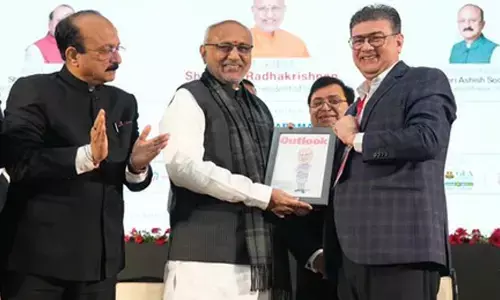IIIT-H robotics research to be presented at ICRA

International Institute of Technology- Hyderabad (IIIT-H), Robotics Research Centre, has come up with a breakthrough in robotics with a modular stair-climbing robots that can dissemble and reassemble for effective surveillance, visual servoing using convolutional neural networks and reconstructing vehicles from a single (RGB) image for autonomous driving.
Hyderabad: International Institute of Technology- Hyderabad (IIIT-H), Robotics Research Centre, has come up with a breakthrough in robotics with a modular stair-climbing robots that can dissemble and reassemble for effective surveillance, visual servoing using convolutional neural networks and reconstructing vehicles from a single (RGB) image for autonomous driving.
The research papers and prototypes will be presented at the International Conference on Robotics and Automation (ICRA) in Singapore from May 29 to June 3, 2017.Research paper submissions from premier institutes worldwide at ICRA go through a rigorous process of selection by at least three reviewers. Given the highly topical nature of its submissions, and with IIIT-Hyderabad being leaders in visual reconstruction, their research and prototypes made the cut. Under the guidance of associate professor K Madhava Krishna, students at IIIT-Hyderabad are encouraged to explore robotics through various aspects – be it deep learning, computer vision or even artificial intelligence – and apply robotic vision to mobile robots and drones.
In keeping with the conference’s theme of “Innovation, Entrepreneurship, and Real-world Solutions”, IIIT-Hyderabad’s Robotics Research Centre will be presenting these papers: Detachable Modular Robot capable of Cooperative Climbing and Multi Agent Exploration by Sri Harsha Turlapati, Ankur Srivastava, K. Madhava Krishna and Suril V Shah.“Imagine a disaster diminution situation, or a search and rescue mission where you need to be able to enter various arenas (most possibly dangerous ones) in the most agile way possible and without being detected.
Fulfilling these specifications, students at the Robotics Research have built a Detachable Compliant Modular Robot (DCMR) prototype that performs concurrent scene exploration by detaching into numerous parts and reattach itself to climb stairs of almost any type in urban settings. The DCMR has been built using both the Uneven Terrain Navigation and Multi Agent Systems (MAS) specifications. The robot comprises a spring that can climb all sorts of stairs, and an extra set of actuators per module to enable the detachment and re-attachment of the modules.
These DCMRs can also move through crammed spaces by detaching itself from one another.Robots normally need to have an active perception of their surroundings in order to move, but these are optimized to handle various terrains at the same time” says Sri Harsha Turlapati.Exploring Convolutional Networks for End-to-End Visual Servoing by Aseem Saxena, Harit Pandya, Gourav Kumar and K Madhava Krishna.“An end-to-end learning based approach for visual servoing in diverse scenes where the knowledge of camera parameters and scene geometry is not available previously.
They achieved this by training a convolutional neural network over colour images with synchronised camera poses. They also demonstrated the efficacy and robustness of the approach for a wide range of cameraposes in both indoor as well as outdoor environments and using experiments performed in simulation and using a quadrotor”, says Aseem Saxena.
Reconstructing Vechicles from a Single Image: Shape Priors for Road Scene Understanding by J Krishna Murthy, G V Sai Krishna, Falak Chhaya and K. Madhava Krishna.“With automatic and autonomous driving emerging as the latest in robotic study, the robot vision community has been realising the importance of understanding road scenes; many of these extensively using LiDAR or stereo camera rigs.
These however are very expensive, given the extensive systems in use. And an increasing interest is being shown to replace these expensive systems with cheaper off-the-shelf cameras”, says G V Sai Krishna. Students at IIIT Hyderabad have taken this interesting challenge and solved the specific problem of recovering 3D shapes and pose of vehicles, given a single (RGB) image.
The basic premise used has been the fact that human beings have fine visual perceptive ability that can recognize external information and perceive the 3D structure from a single image thanks to vast prior knowledge on how various 3D shapes project in 2D.
Commenting on the achievements of the students K Madhava Krishna, associate professor, IIIT-H says, “The students have placed similar capabilities in the machines they have built, by learning the shapes, and using them along with other constraints arising from projective imaging geometry in a robust optimization framework. The publication also comprises a novel shape-aware adjustment scheme which estimates the 3D pose and shape of a vehicle, given the shape prior and keypoint detections”.















